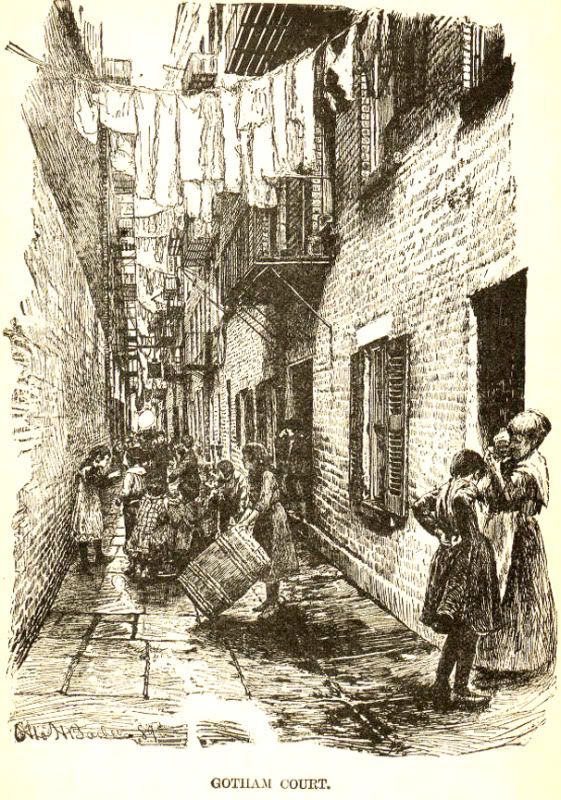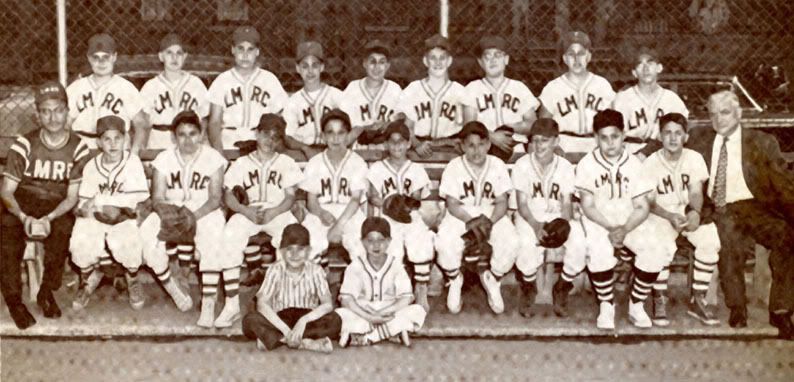Mcny Gotham Court
from the museum of the city of new york's digital collection..
I alternated many of the images with close ups of certain parts of interest. Notice the advertisement for a 1889 event at Jones Wood on page 9 of the document.It looks like it was sponsored by a Edward Lennon. That must have been a world apart from the horrors of life in the Fourth Ward at that time
Showing posts with label gotham court. Show all posts
Showing posts with label gotham court. Show all posts
Sunday, January 2, 2011
Tuesday, December 21, 2010
Gotham Court, Sweeney's Shambles and Paradise Alley
Knickerbocker Village's favorite NYC historian Kevin Baker will be speaking before Bronx teachers next month as part of a Teaching American History Grant. The topic will be his book Paradise Alley. Here, in an excerpt from the full interview, Kevin discusses the history surrounding the book
A Conversation with Kevin Baker
Q. You've written Dreamland, a novel set in 1910s New York, and you've done research for Harold Evan's The American Century. How did you come across the historical events described in Paradise Alley and why did you decide to write about them?
KB: I first came across the events depicted in Paradise Alley, when my father gave me a copy of Herbert Asbury's The Gangs of New York to read, over 30 years ago. Having grown up in America in the 1960s, I was not terribly surprised by the idea of urban riots, or by protests over a draft — it seemed, in those days, that every time you turned on the TV you saw a halftrack rolling down a city street — but I was stunned by how violent and furious these protests from the 1860s were. Asbury's book, which is now emerging as a classic of our hidden history, is not terribly long on accuracy; an estimated 119 people died, instead of the 2,000 he claims. But it was, still, the worst riot in American history, and something that was very alien to the received history I had about the Civil War, and what kind of a fight it was, and who the good guys and the bad guys were. I wanted to know more — and what I learned, I thought, made for a great story.
Q. You've placed three women at the center of your narrative and each is portrayed with a striking degree of intimacy. How did you, as a man, get to know these characters? Was it difficult finding their voices?
KB: I always find it difficult to get any character's voice down. I know that the conventional wisdom of today is that one should not be able to truly depict anyone not exactly one's own self, but that would mean the death of literature. There is always a lot of groping in the dark, and it's even harder, of course, when you're dealing with a different time period. I have been fortunate enough to know many wonderful women in my life, my wife, sisters, mother, many friends. I have learned a great deal from them all, and I feel that I know many of them better than the male friends and relatives I have. The gap between the sexes is great, but it is not so wide as to preclude the basics of human love, fear, desire, greed, etc.
Q. In Paradise Alley, you're delving deep into the heart of Irish Roman-Catholicism. Was it easy to become familiar with the cultural norms and behavioral patterns of a different religion?
KB: As it happens, much of my father's family is Catholic, and I have attended a number of masses in my life. It's not exactly another world to me. But yes, I was brought up in different Protestant faiths — and on top of this difference, I had to find out what the Catholic church in America was like in the 19th century. In this endeavor, I was fortunate enough to have the help of several priests in the New York area, all of whom had a good historical perspective, and several books that I cite in the bibliography. The differences between then and now are not vast, but in general the Catholic church in America was, at the time of Paradise Alley, poorer, more defensive, more besieged, more persecuted, somewhat more proper and conservative, and perhaps a little more directly involved with life in the streets, where most of its communicants were living.
Q. Your use of geographical landmarks brings to life vividly the anatomy of historical New York. Which places are real and which are fictional? Where could we find Paradise Alley today?
KB: Paradise Alley was a very real place, an alley that emerged from a terrible double tenement known as "Sweeney's Shambles." Both are long gone, thank goodness. Their approximate location was just off Cherry Street, behind where the New York Post printing plant is today, and about where the Smith Houses currently stand. The anatomy of the whole Fourth Ward over there is very much changed now, and scarcely recognizable. Gone, too, are the old homes of The New York Times and the Tribune, the grand old hotels such as the Astor House and the St. Nicholas, and most of the tenements of the old Five Points.
But many other buildings are still standing, such as the churchyard of the Old St. Patrick's (the church itself burned and was rebuilt shortly after the Civil War), where Tom meets Deirdre; New York's graceful, Georgian City Hall; Federal Hall, the old Sub-Treasury building, where they kept the gold, and quite a few older residential buildings. The oldest known tenement, for instance — dating back to at least 1824 — still stands, at 65 Mott Street, in the heart of Chinatown. The Lower East Side of New York is truly a unique place in America, a neighborhood that has been a poor, immigrant community continuously for at least 175 years. The ethnic groups have changed — from Irish and German, to Jewish, Eastern European, and Italian, to Hispanic and Asian — but the flavor of struggle, of aspiration, of sheer density and poverty, still remains. To get a very vivid idea of how new Americans lived from the 1850s to the 1930s, I would highly recommend that one visit The Lower East Side Tenement Museum, at 97 Orchard Street, which has preserved an old tenement and created inside replicas of how various apartments looked during different ages. I certainly did — which is why no location in Paradise Alley is made up out of wholecloth.
Labels:
gotham court,
kevin baker,
paradise alley,
Ward 4
Monday, April 19, 2010
The Yellow Kid, Hogan's Alley and Gotham Court
Outcault took his inspiration for the kid's Hogan's Alley locale from the real life 19th Century Gotham Court of the Fourth Ward
Friday, June 26, 2009
The Fourth Ward In the 19th Century
Fourth Ward 2
From Professor Baldwin's comprehensive site at the University of Connecticut
From Professor Baldwin's comprehensive site at the University of Connecticut
The Fourth Ward: Life and Death in New York, 1860-1870
The tenant-house population of this city would make a city almost as large as Philadelphia, or two larger than Baltimore and Washington, or Boston and Chicago.It has been ascertained by those who have searched out the matter, that over four-fifths of the poverty and crime in the city are due to drunkenness.Were the victims of this vice -- the ruined in fortune and character -- the ill-clad, cold, hungry, sick, crushed wives and children -- the friendless widows and orphans -- the homeless and perishing young girls -- to come down from their garrets, or up from their basements and cellars, and out from their burrowing places where a ray of sunlight never enters -- where pure air is never breathed -- the sad procession would reach from the Battery to Harlem. Whose sympathy would not be moved to its depths at such a sight? yet these unfortunate creatures are here all around us, packed in their miserable abodes in a manner which surpasses belief.There are blocks not over 400 feet square that contain about twice as many people as the whole of Fifth avenue. The Fourth Ward, in which this Mission is located, contains about 50 acres (35 to 40 small blocks), yet its population would make a larger city than Utica, N.Y., or three such cities as Saratoga Springs.One tenant house in it (Gotham Court) often contains over 1,000 of these poor creatures. On one little spot near the Mission, 240 feet by 150, there are 20 tenant-house, 111 families, 5 stables, a soap and candle factory, and a tan-yard. There are less than two dwelling-houses in the ward for each rum-hole.
Labels:
cherry hill,
gotham court,
paradise alley,
Ward 4
Gotham Court
An attempt was made in the late 1800's to provide better living conditions in this area of Cherry Hill known as Gotham Court. Formerly it was the site of the notorious Paradise Alley which was the backdrop for part of Kevin Baker's novel of that name
gotham-court-1871-1892
gotham-court-1871-1892
Labels:
cherry hill,
gotham court,
nytimes,
paradise alley,
Ward 4
Subscribe to:
Posts (Atom)


























